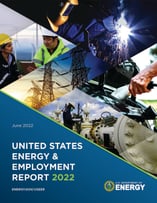 The U.S. Department of Energy (DOE) recently released the U.S. Energy Employment Report (USEER), an annual report that takes a comprehensive look at national and state-level employment data for the clean energy sector. DOE’s analysis found that the clean energy sector job growth increased by 4 percent in 2021 versus 2020 despite the impacts of the COVID-19 pandemic.
The U.S. Department of Energy (DOE) recently released the U.S. Energy Employment Report (USEER), an annual report that takes a comprehensive look at national and state-level employment data for the clean energy sector. DOE’s analysis found that the clean energy sector job growth increased by 4 percent in 2021 versus 2020 despite the impacts of the COVID-19 pandemic.
A Deeper Dive
The USEER, originally launched in 2016, assesses five major energy industries: electric power generation; motor vehicles; transmission, distribution, and storage; fuels; and energy efficiency. The findings show that all sectors experienced growth except for fuels.
The total energy efficiency employment in 2021 was 2,164,914 workers, an increase of 2.7% from 2020. Job growth was especially strong in traditional heating, ventilation, and air conditioning (adding 17,740 jobs). Growth in employment last year came on the heels of massive job losses in 2020 because of the COVID-19 pandemic, which resulted in a total loss of 271,719 jobs. Still, the energy efficiency sector grew more modestly than the overall energy sector (2.7 percent versus 4 percent) and did not make up for the job losses in 2020.
The construction industry represents the largest industry within EE for jobs. The sector employed 1,169,407 workers, an increase of over 25,131 over 2020 and the largest category for new energy efficiency job growth. However, construction also had the highest percentage of respondents indicating that it was “very difficult” or “somewhat difficult” to find employees, with 91 percent citing challenges.
The three U.S. states that added the most overall new energy jobs were Michigan (35,500), Texas (30,90), and California (29,400).
Jobs in Net Zero Areas
In 2021, jobs in zero-emissions aligned areas made up 40 percent of the total energy jobs, according to the report. These jobs include those in renewable energy; grid technologies and storage; traditional electricity transmission and non-fossil distribution; nuclear energy; a subset of energy efficiency biofuels; and plug-in hybrid, fully electric and hydrogen fuel cell vehicles, and components.
To access the full report, click here.





